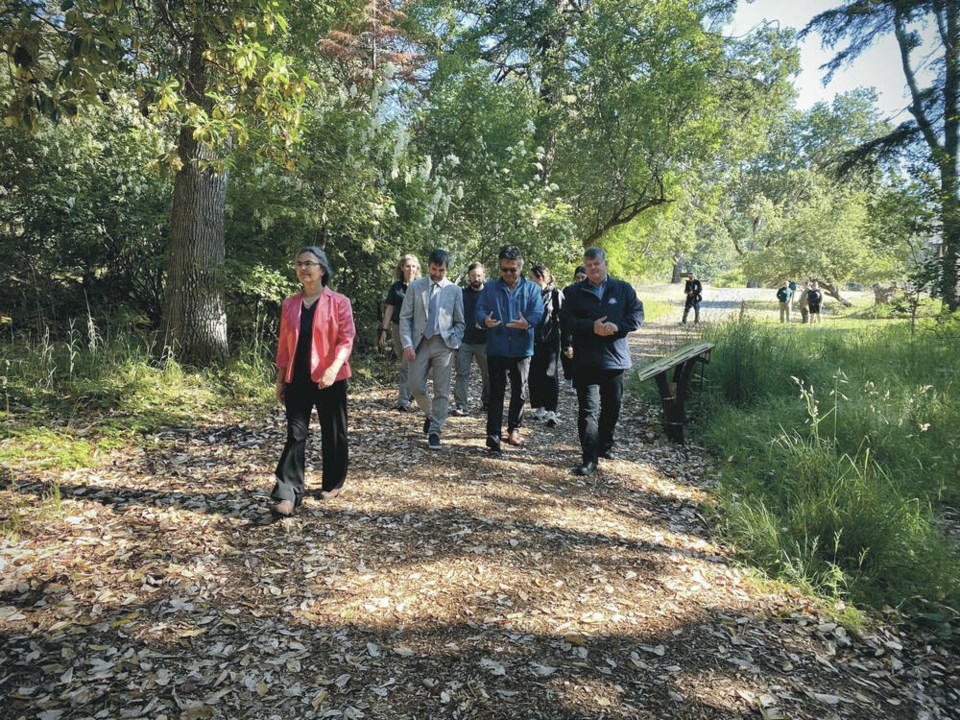T’Sou-ke First Nation Chief Gordon Planes has watched the landscapes of Vancouver Island twist and turn over the years, struggling to maintain healthy ecosystems.
As a trail guide, logger and fisherman, he has been around the big rock many times, and he has seen how industry and now climate change are affecting the animals, fish, marine life, trees and plants — and human beings.
So his nation is supporting a new initiative by Parks Canada and an Indigenous-led partnership that will see local knowledge used to conserve ecological corridors on the coast from Victoria to Tofino that link up with parks and protected areas to stem the loss of biodiversity and key species at risk.
“I think we really need to look at this Island as a living, breathing entity, and ask ourselves how do we work with all living things to make sure the integrity stays intact,” Planes said Wednesday at Fort Rodd Hill National Historic Site in Colwood.
Planes said creating ecological corridors for cougars and bear and fish and crabs is key in curbing the loss of biodiversity and helping species adapt to climate change.
The idea is that by gathering local knowledge to link protected and conserved areas, we can help species move, interact and find habitat and food on the land and sea across the Island.
Steven Guilbeault, federal minister of environment and climate change and minister responsible for Parks Canada, announced $525,000 in funding to support a pilot project by the Indigenous-led Westcoast Stewardship Corridor, a group formed in 2020 to brainstorm the big picture of healthier ecosystems.
Nitya Chari Harris, who is leading the steering committee for the Westcoast Stewardship Corridor, said 13 First Nations and other conservation-minded individuals and groups are being pulled together to begin planning the process.
Harris said the aim is based on the Nuu-chah-nulth guiding principles of Hishuk’ish tsawalk (interconnectedness), Uu-a-thluk (the responsibility to take care of), Łisaak (respect for all things living and non-living), and the Coast Salish principle of Naut’sa mawt (together as one).
She said it’s a long-term, multi-generational project that will bring together elders and youth to collaborate, share knowledge and plan for greater ecological, cultural and economic connectivity.
“It’s to connect and safeguard habitats and to promote the well-being of both nature and people,” said Harris. “It’s about creating a corridor of shared values that not only enhance the lands, waters and wildlife, but also create a sustainable economy for all the people who live there.”
She said the initial steps will be inviting representatives from the 13 First Nations to sit on the steering committee to better understand each nation’s stewardship visions and values. The new funding from Parks Canada will allow the committee to engage with First Nations in the first phase of the corridor, culminating in a large gathering in the fall to hear from all Nations.
The vision is eventually to cover all of the Island.
“Every nation we’ve talked to so far are in different stages,” Harris said in an interview. “Some are right into it, saying let’s do it; others are more concerned about things like housing or economic situations right now, and that’s important because we need to go in with the idea of what’s on the ground is that reality today.
“But almost everybody gets the fact that without a balanced ecosystem and without that ecosystem providing for the people living there, there’s going to be nothing left. There’s no easy solution here. We’re working with different Nations and trying to figure out what conservation projects we can help them with, how can we involve the youth in some projects and getting knowledge from elders and seeing what Nations are currently working together.”
She said First Nations might have conservation projects already going in their territories, but find it difficult to cross borders into other Nations, so the corridor group wants to facilitate talks on co-operation.
She said conservation areas won’t necessarily be a specific route on a map during initial stages of the plan.
“We’re looking at it as where do the wolves want to go, where are the salmon swimming, so we need to talk about pathways with First Nations” before proceeding with mapping.
“That’s what this is all about at this stage: getting the conversations and knowledge going,” said Harris. “How do we figure out the ecological balances … that’s a big part of it, but it’s also social, cultural and spiritual.”
She said First Nations economic ventures, such as logging and fishing, will have to be respected.
“Everybody has economic interests and I think it’s an important piece of this,” said Harris.
“But more and more people are talking about a restoration economy and what that will look like,” she said. “How do we give skills to youth so they can contribute to that restoration and will that contribute to the health of the Nation — and to the forests and wildlife. It’s not going to happen overnight, but we’ve got to look at possibilities that will be with us for the next hundred years.
“We’re hoping these solutions to an ecological balance will start bubbling out as we start talking.”
Planes said the T’Sou’ke First Nation has overlapping territories with five First Nations on the Island and Washington state.
“We’ve seen the changes over the years and we know it’s going to be a big project to change a forest because of logging practices over the decades,” said Planes, adding he was part of that with Western Forest Products in the 1970s and 1980s. “It’s not coming back the way it should. These projects cost a lot of money, so we have to find ways of incrementally working toward something that’s bigger than all of us.”
>>> To comment on this article, write a letter to the editor: [email protected]



